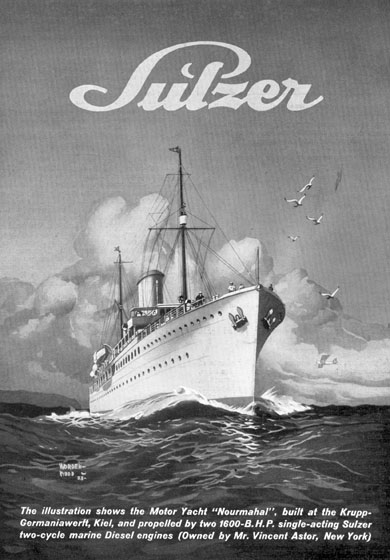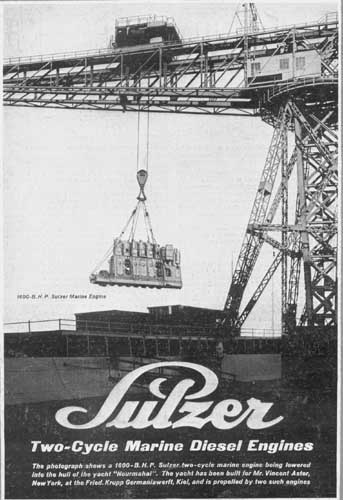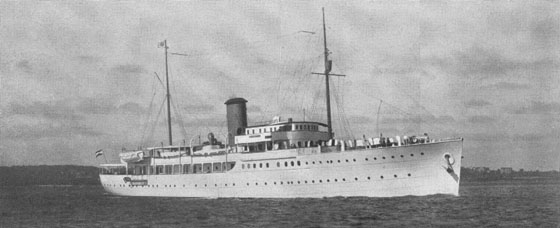
The Nourmahal was a motor yacht ordered by William Vincent Astor from Friederich Krupp Germaniawerft, A.G., Kiel, Germany. It was delivered during 1928 presumably as a replacement for Astor's previous yacht Noma. Time magazine on February 6th 1928 featured a cover article on Astor and the Nourmahal which was described as the finest private yacht of its era.
William Astor, more commonly known as Vincent, was the son of John Jacob Astor IV and Ava Willing. His father died in the Titanic disaster leaving a $75 million estate to Vincent at age twenty. This wealth did not keep him from performing his civic duties, Vincent served in the Navy during World War I, upon his return he ensured that his inherited resources were used to the greater good of the community. He also owned Newsweek magazine and served on the boards of Western Union, Chase Manhattan Bank and The United States Lines, as well as a trustee of the New York Public Library and New York Zoological Society.
The yacht would frequently be used on voyages of a philanthropic nature. In the spring of 1930 for instance Astor and a group of experts from the New York Aquarium, American Museum of Natural History and Brooklyn Botanic Garden made an expedition to the Galapagos Islands, returning with many reef fishes, a pair of penguins, tortoises, iguanas, as well as a large botanical collection to be housed at the Brooklyn Botanic Garden. They sailed from Miami on March 1, 1930, and arrived in the Galapagos on April 1st. Further visits to this area took place visits in 1932, 1933 & 1936 - 1938. The yacht would also occasionally sail with US Presidents aboard.
The range of the yacht varied, at the maximum speed of 13.7 knots it had a range of 12,700 miles. When travelling at 8.0 knots it could achieve a 23,500 mile range.
On August 16th 1930 the Nourmahal was at New London to welcome the Shamrock V, which would represent England in the America Cup yacht race.
On February 15th 1933, Guiseppe Zangara attempted to assassinate Franklin D. Roosevelt while the then President-elect was in Miami, Florida. The gunmen was unsuccessful in his attempt on Roosevelt's life, but another member of the group, Chicago's Mayor Anton Cermak did succumb to his wounds shortly afterwards. Astor was friends with Franklin D. Roosevelt, and it was to the Nourmahal that FDR retreated after this assassination attempt. Thereafter, he joined Astor on the yacht once a year.
During August 1933 the yacht was again host to President Roosevelt, his Hyde Park vacation ended with a cruise down the Hudson as the guest of Vincent Astor and a small group of non-political friends. With the President on board the Nourmahal was permitted to fly the Presidential flag — four white stars on a blue field. President Roosevelt believed it was the first time in U. S. history that this emblem had been used on a private yacht. Trailing the Nourmahal were two naval watchdogs, the destroyers Twiggs and Manley. From the Hudson the Nourmahal rounded Manhattan Island, passed through Hell Gate and out into Long Island Sound. Next morning it was anchored in Fort Pond Bay near Montauk Point. Following a day's fishing the Nourmahal that night sailed down the coast to bring the President back to Washington the day after Labor Day.
On March 29th 1934 the Nourmahal arrived in Nassau, Bahamas with President Roosevelt for a holiday.
On Easter Sunday April 1st 1934 the Nourmahal was part of a first for the US President when President Franklin D Roosevelt, as Commander in Chief, led a worship service for the Navy. The chaplain was absent leaving the Commander in Chief to read the service from the Episcopal Book of Common Prayer on Nourmahal's quarterdeck. Officers and men of the USS Ellis were present.
September 15th 1934 - Newport, Rhode Island; the Nourmahal was present to watch the America's Cup yacht race. President Roosevelt was a guest on the Nourmahal to watch the event, which ended without a winner after the wind died and none of the competitors completed the race within the five and a half hour time limit.
March 27th 1935 - whilst on a fortnight's fishing trip in Bahama waters President Roosevelt entertained the Duke & Duchess of Kent and the Governor, Sir Bede & Lady Clifford aboard the Nourmahal.
On January 23rd/24th 1936 the Nourmahal negotiated the Panama Canal en-route from New York to Los Angeles.
On April 8th/9th 1936 the Nourmahal negotiated the Panama Canal en-route from Los Angeles to New York.
During the spring of 1937 the Nourmahal returned to Brooklyn after a 12,000-mile trip to the South Pacific, among Astor's gifts for the Staten Island Zoo: a kinkajou, two porpoises, four macaws and eight iguanas.
 | A photograph from the Sulzer Technical Review No.2 of 1928 shows one of the 1,600bhp Sulzer two cycle marine engines being lowered into the hull of the yacht Nourmahal at the Fried. Krupp Germaniawerft, Kiel shipyard. A telegram sent to Sulzer Brothers on May 31st 1928 from Mr Theodore Ferris, the naval architect who designed the vessel read: 'Report trials Astors Nourmahal indicates exceptional performance of engines. Please accept my congratulations'. In addition Mr Astor expressed to Sulzer Brothers his great satisfaction with the engines. |
Date 1938?? The Nouurmahal was used for a three month cruise to the Fuji Islands, with William Vincent Astor taking along his future wife Mary (Min) Cushing.
On February 9th 1938 the Nourmahal negotiated the Panama Canal en-route from New York to La Libertad, Ecuador.
On May 20th/21st 1938 the Nourmahal negotiated the Panama Canal en-route from Honolulu to New York.
On January 22nd 1939 the Imperial Airways flying boat Cavalier en-route from New York to Bermuda with eight passengers and five crew encountered icing conditions about 300 miles east of Norfolk, Virginia. The conditions forced the plane to land on the ocean, shortly after which it sank. Many resources were called upon to search for the survivors, including the Nourmahal en-route from New York to the Pacific Ocean. The steamer Baytown was first on the scene, rescuing all but two passengers and one crew member who were presumed drowned.
On January 28th/29th 1939 the Nourmahal negotiated the Panama Canal en-route from New York to Los Angeles.
During 1939 the Nourmahal carried Astor and President Roosevelt’s cousin, Kermit Roosevelt, on a supposed cruise to the Marshall Islands, the voyage may have been to seek information on the fate of Amelia Earhart. The Nourmahal was denied access to the Japanese held Marshall Islands. It is also reported that the Nourmahal had made a similar voyage in 1938.
The Nourmahal's duties changed completely when the yacht was chartered for $1 to the Coast Guard effective August 21st 1940 for service as a weather station vessel in the Coast Guard Reserve fleet, classified WPG-72. She was reconditioned at the Coast Guard Yard from September 22nd through December 1st 1941 and then assigned to New York. She departed the Yard and sailed for Norfolk for outfitting and supplies on December 1st 1941 and then relieved USCGC Spencer on Weather Station #2 on December 29th. On January 19th 1942 she sailed for New York. She was then transferred to Navy control under a bareboat charter from William Vincent Astor on March 3rd 1942 but still maintained a Coast Guard crew. She was designated USS Nourmahal (PG-72) April 9th 1943 and purchased for $300,000 by the Navy June 29th 1943 in accordance with an option in the original charter agreement. Vessels like the Nourmahal were able to release the Coast Guard cutters from weather station duty to anti-submarine service.
Nourmahal was transferred to the Coast Guard December 29th 1943, reclassified WPG-122 and was struck from the Navy List January 12th 1944. Until the end of April 1946 she served the Coast Guard based at Boston, Massachusetts, escorting convoys from New York to Guantanamo Bay, Cuba and back as well as duty as the flagship of the Commander, Eastern Sea Frontier, or on ocean station weather patrol. After April 1st 1944 she was assigned to the U.S. Atlantic Fleet as a weather observation vessel through 1946. Thereafter she provided towing services at the Coast Guard Yard, Curtis Bay, Maryland.
She returned to the custody of the Commandant of the 5th Naval District in May 1947 for berthing at Norfolk. Transferred to the Maritime Administration July 18th 1948, she was assigned to the James River Maritime Reserve Fleet. She was sold by the Maritime Administration September 11th 1964 to Hughes Brothers, Inc. Hampden, Maine for scrap.
Built: Krupp, Keil, Germany
Launched: 1928
Displacement: 3,200 tons
Length: 263'10"
Breadth: 41'6"
Draught: 18'5"
Propulsion: Two Sulzer (Winterthur) 6S47 1,600bhp two cycle 6 cylinder single acting diesel engines
Auxiliary engines: one 4RKH20 and two 2RKH20 totaling 200hp at 425rpm
Screws: Two
Speed: 13.7 knots
Passengers:
Wartime details:
Displacement:
(1941) 2,250 tons.
(1945) 3,200 tons.
Complement:
(1941) 98 enlisted, 9 officers
(1945) 101 enlisted, 1 warrant, 9 officers
Electronics:
Detection Radar: None in 1941; SF in 1945
Sonar: None
Armament:
(1941): 2 x 4"/50 single mount; 6 x .50 caliber machine guns; 8 x .30 caliber machine guns; 2 x depth charge tracks
(1945): 2 x 4"/50 single mount; 6 x 20 mm/80 single mount; 8 x .30 caliber machine guns; 2 x depth charge tracks; 4 x depth charge projectors; 2 x mousetraps.

Resources:
Miscellaneous sources from a variety of websites and other period printed materials.
Panama Canal Record (Isthmian Canal Commission).
Trove: next#71 (last seq 1380)
Singapore Newspapers/National Library Singapore Archive.
Page added May 11th 2007.
Last updated November 10th 2022.
Return to Ship menu
Return to Picture menu